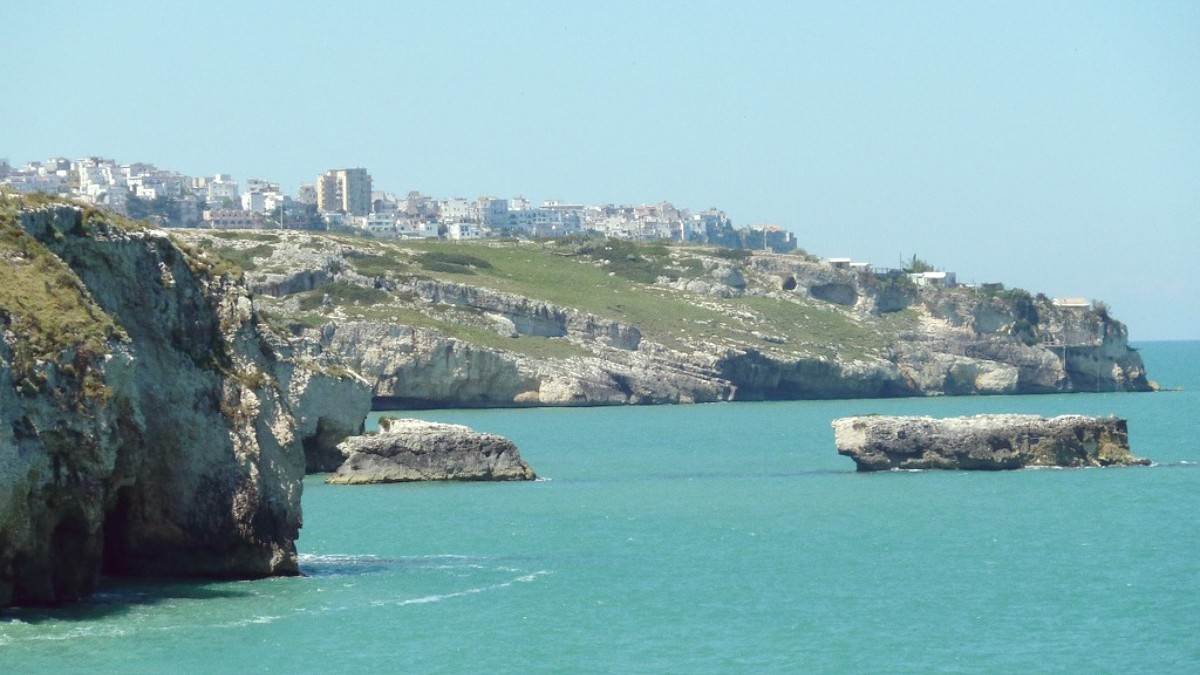
Puglia, Italy
Olive oil is a core ingredient; Puglia is Italy's largest olive oil producer. Durum wheat pasta, especially the iconic orecchiette, forms a backbone of many meals. Fresh vegetables like broccoli rabe (cime di rapa), chicory, fava beans, and sun-ripened tomatoes are used generously. Legumes, including chickpeas and lentils, also feature prominently.
Seafood is abundant and fresh, given Vieste's coastal location. Expect to find dishes featuring octopus, mussels, anchovies, sea bream, and various other fish caught daily from the Adriatic.
Lunch ("pranzo") is typically from 1:00 PM to 2:30 PM. Dinner ("cena") usually starts around 7:30 PM and can extend until 10:30 PM or later, especially in summer. Breakfast ("colazione") is usually light.
A "coperto" (cover charge, typically €1-€3 per person) is a charge for table service, bread, and linen. A "servizio" (service charge, 10-15%) may also appear, especially in more tourist-oriented establishments. If either is on the bill, no additional tip is common. Rounding up the bill for good service is common when no service charge is present.
Espresso is the standard. Ordering a cappuccino after lunch or dinner is generally not done by locals; it is considered a breakfast drink. Wait to be seated in restaurants unless indicated otherwise.
"Little ear" pasta served with sautéed turnip greens, garlic, chili, and sometimes anchovies. This is a quintessential Puglian pasta dish, simple yet flavorful.
Find it in most traditional trattorias.
Focaccia Barese: A thick, soft, savory bread, often topped with cherry tomatoes, olives, and local olive oil. Panzerotto: A fried turnover similar to a small calzone, typically filled with mozzarella and tomato.
Widely available in bakeries ("panifici"), pizzerias, and "friggitorie."
Polpo in Pignata: Octopus stew slowly cooked in a traditional earthenware pot. Tiella Barese: A baked dish layered with rice, potatoes, and mussels. Friselle: Hard, dried bread rings, topped with fresh tomatoes, olive oil, and oregano.
Common in seafood restaurants for Polpo; Tiella is found throughout coastal Puglia; Friselle are perfect for light meals.
Small, savory, ring-shaped crackers, often flavored with olive oil, fennel seeds, or chili. A perfect snack or "aperitivo" accompaniment.
Espresso is standard. "Caffè leccese" (iced coffee with almond milk) is popular in summer. Local and national beers are widely available.
Vieste has a limited number of upscale restaurants. These feature refined Puglian cuisine or modern Italian dishes, often with panoramic sea views. They focus on high-quality ingredients and presentation.
Numerous "ristorantes" and "trattorias" feature traditional Puglian and Italian fare. Many specialize in fresh seafood. These places offer good value and an authentic dining experience.
The Mercato Coperto (Covered Market) offers fresh local produce, regional cheeses, cured meats, and olive oil. Outdoor markets also appear on specific days.
Look for these hot and savory items at "friggitorie" (fried food shops), bakeries, and street food vendors.
Perfect for a quick snack while exploring.
Seek out "rustico" (a savory puff pastry from Lecce) and "sgagliozze" (fried polenta squares) for quick, flavorful bites.
Found in central areas or markets.
Authentic, traditional dining.
Broader menu, sometimes more upscale.
Sweet pastries and desserts.
Coffee and light bites.
Awareness for gluten-free dining is growing in Italy. Many pizzerias offer gluten-free crusts. Seek "senza glutine" on menus.
Italy has strict regulations for certified gluten-free products, making packaged options generally safe and available in supermarkets.
Clearly communicate any allergies to restaurant staff. Learning a few Italian phrases for your specific allergy is useful (e.g., "Sono allergico/a..." - I am allergic to...).
A Food allergy translation card is also helpful for clear understanding.
Restaurant staff often share information on ingredients and preparation methods.
Many supermarkets stock a range of packaged gluten-free products, identifiable by specific certifications.
Some agriturismo and specialized culinary schools in the broader Puglia region offer hands-on classes on making orecchiette or other regional dishes. Dedicated options directly in Vieste might be limited, but nearby countryside locations could provide these experiences. Broader Gargano or Puglia culinary tours may include stops or experiences highlighting local products and traditions.
Explore GetYourGuide toursOpportunities exist to visit local olive oil mills ("frantoio"), vineyards, or cheese producers in the surrounding Gargano countryside. These visits often include tastings and share insight into the production processes.
Throughout Puglia, especially in summer and autumn, numerous "sagre" (food festivals) celebrate local produce. These festivals focus on items like olive oil, tomatoes, seafood, or wine. They offer a lively atmosphere and a chance to taste various specialties.
Puglia is renowned for its olive oil production, a staple in its cuisine.
Visit a local "frantoio" for a tasting experience.
The region produces robust red wines like Primitivo and Negroamaro. Sampling these wines locally complements the dining experience.
Many local restaurants offer excellent house wine selections.
Learn to prepare traditional Puglian pasta like orecchiette.
Taste regional wines and visit olive oil mills for a truly local flavor.
Enjoy fresh seafood on unique traditional fishing structures over the sea.
Engaging with the local food scene is a core part of the Vieste experience. Embrace the "cucina povera" philosophy for authentic flavors.